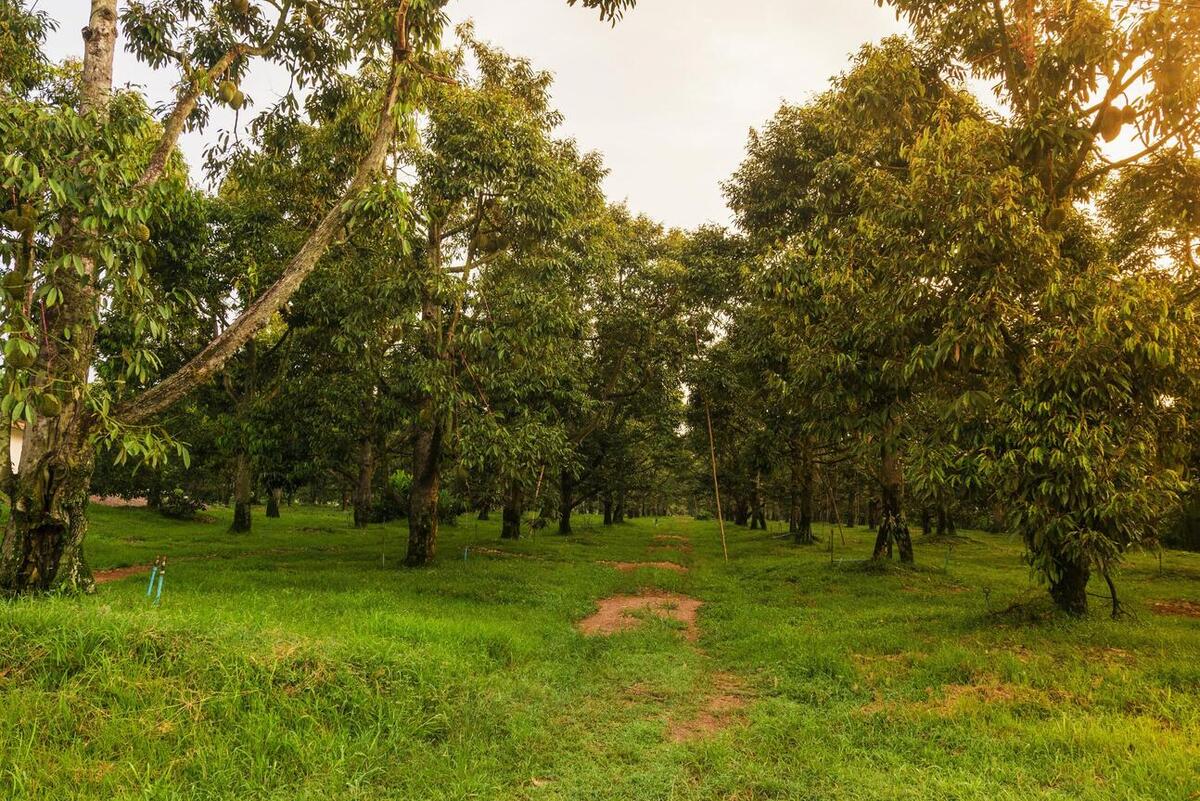Home>Types of Gardening>Ornamental Gardening>How Many Tulip Bulbs Per Square Foot


Ornamental Gardening
How Many Tulip Bulbs Per Square Foot
Published: January 20, 2024
Discover the ideal quantity of tulip bulbs to plant per square foot for a stunning ornamental garden. Learn expert tips for successful ornamental gardening.
(Many of the links in this article redirect to a specific reviewed product. Your purchase of these products through affiliate links helps to generate commission for Chicagolandgardening.com, at no extra cost. Learn more)
Table of Contents
Introduction
Ornamental gardening is an art form that allows individuals to transform outdoor spaces into vibrant, visually appealing landscapes. One of the most beloved flowers in ornamental gardening is the tulip, renowned for its captivating beauty and wide array of colors. When it comes to planting tulips, a common question that arises is, "How many tulip bulbs should be planted per square foot?" This query is crucial for achieving an optimal display of tulips in a garden or landscape.
Understanding the ideal tulip bulb density per square foot is essential for ensuring that the flowers thrive and create a stunning visual impact. Factors such as soil quality, bulb size, and desired visual effect all play a role in determining the appropriate planting density. By delving into the factors influencing tulip bulb density and learning how to calculate and implement the right density, gardeners can elevate their ornamental gardening endeavors to new heights.
Join us as we explore the intricacies of tulip bulb density, providing insights into the factors influencing it and offering guidance on achieving the perfect planting density for a breathtaking tulip display. Whether you're a seasoned ornamental gardener or a novice enthusiast, understanding the nuances of tulip bulb density will undoubtedly enhance your gardening journey. Let's embark on this enlightening exploration together, uncovering the secrets to cultivating a mesmerizing tapestry of tulips in your outdoor sanctuary.
Factors Affecting Tulip Bulb Density
Several key factors influence the optimal density at which tulip bulbs should be planted per square foot. Understanding these factors is crucial for achieving a thriving and visually stunning tulip display. Let’s delve into the primary elements that impact tulip bulb density:
- Desired Visual Effect: The desired visual impact of the tulip display plays a significant role in determining the bulb density. For a more natural and informal look, a lower density may be preferred, allowing the tulips to sway gracefully in the breeze and create a charming, meadow-like ambiance. Conversely, a higher bulb density can produce a more formal and densely packed appearance, ideal for creating a striking visual statement or a vibrant burst of color.
- Bulb Size and Variety: The size and variety of tulip bulbs directly influence the recommended planting density. Larger bulbs typically require more space to reach their full potential, while smaller bulbs can be planted more densely. Additionally, certain tulip varieties may naturally lend themselves to being planted at higher or lower densities based on their growth habits and the visual effect they are intended to create.
- Soil Quality and Drainage: The quality of the soil and its drainage capabilities are vital considerations when determining tulip bulb density. Well-draining soil allows for closer bulb spacing, as it reduces the risk of waterlogged conditions that can lead to bulb rot. In contrast, in heavy or poorly draining soils, bulbs should be spaced farther apart to mitigate the risk of water-related issues.
- Climate and Sunlight: Regional climate and sunlight availability also impact tulip bulb density. In cooler climates, where tulips may bloom later and grow more slowly, a higher bulb density can create a fuller and more impactful display. Conversely, in warmer climates, where tulips may grow more vigorously, a lower density may be preferred to prevent overcrowding and competition for resources.
By considering these influential factors, gardeners can make informed decisions regarding the optimal tulip bulb density for their specific gardening environment and aesthetic preferences. The interplay of these elements ultimately shapes the overall visual appeal and health of the tulip display, making it essential to carefully assess each factor when planning the planting layout.
Calculating Tulip Bulb Density
Calculating the appropriate tulip bulb density involves a thoughtful and precise approach to ensure the optimal spacing for a stunning display. By taking into account the available space and the specific characteristics of the tulip bulbs being planted, gardeners can determine the ideal density for their ornamental garden. Here’s how to calculate tulip bulb density effectively:
- Measure the Planting Area: Begin by measuring the area in square feet where the tulips will be planted. This can be achieved by multiplying the length and width of the planting space to obtain the total square footage.
- Consider the Desired Density: Determine the desired bulb density based on the visual effect you wish to achieve and the characteristics of the tulip variety being planted. As mentioned earlier, a lower density creates a more natural look, while a higher density yields a more formal and densely packed appearance.
- Calculate Bulb Spacing: To calculate the spacing between tulip bulbs, divide the total square footage of the planting area by the desired bulb density. For example, if the planting area is 100 square feet and you aim for a density of 8 bulbs per square foot, the calculation would be 100 / 8, resulting in 12.5. This means that each tulip bulb should be spaced approximately 12.5 inches apart to achieve the desired density.
- Adjust for Natural Arrangements: If you prefer a more natural and informal look, consider varying the spacing slightly to avoid a perfectly uniform layout. This slight irregularity can mimic the spontaneous beauty of tulips in their natural habitat, creating a more organic and visually appealing arrangement.
By employing these calculations and considering the desired visual impact, gardeners can effectively determine the appropriate tulip bulb density for their specific planting area. This thoughtful approach ensures that each tulip has adequate space to thrive while contributing to a breathtaking overall display.
Planting Tulip Bulbs at the Right Density
Once the optimal tulip bulb density has been calculated, it’s time to translate this information into the physical act of planting. Ensuring that tulip bulbs are planted at the right density is essential for nurturing healthy growth and achieving the desired visual impact. Here’s a step-by-step guide to planting tulip bulbs at the appropriate density:
- Prepare the Planting Site: Begin by preparing the planting site, ensuring that the soil is well-drained and free of debris. Loosen the soil to a depth of at least 12 inches to provide an optimal environment for the tulip bulbs to establish their root systems.
- Mark Planting Locations: Using the calculated bulb spacing, mark the planting locations with small stakes or environmentally friendly spray paint. This step helps maintain consistency and accuracy during the planting process.
- Plant at the Correct Depth: When planting tulip bulbs, ensure that they are placed at the appropriate depth, typically around 6 to 8 inches deep, depending on the bulb size. This depth provides insulation and stability while allowing the emerging shoots to reach the surface at the right time.
- Space and Plant Carefully: As you plant each tulip bulb, pay close attention to the calculated spacing and the desired arrangement. Carefully space the bulbs according to the predetermined density, taking into account the variations that may contribute to a more natural and visually appealing layout.
- Protect and Mulch: After planting the tulip bulbs, consider protecting the area from potential disturbances such as foraging animals or extreme weather conditions. Applying a layer of mulch can also help regulate soil temperature and moisture, contributing to the overall health of the bulbs.
By following these guidelines and taking the calculated bulb density into consideration, gardeners can ensure that their tulip bulbs are planted with precision and care. This approach not only promotes the healthy development of the tulips but also sets the stage for a captivating and harmonious display that reflects the calculated density and desired visual effect.
Conclusion
Mastering the art of planting tulip bulbs at the ideal density is a rewarding endeavor that elevates the beauty and impact of ornamental gardens. By considering the various factors that influence tulip bulb density, calculating the optimal spacing, and planting with precision, gardeners can orchestrate a breathtaking display that captivates the senses and enhances outdoor spaces.
Understanding the interplay between factors such as desired visual effect, bulb size, soil quality, and climate empowers gardeners to make informed decisions when determining the appropriate tulip bulb density for their specific gardening environment. This thoughtful approach ensures that each tulip has the space and resources needed to thrive, contributing to a vibrant and healthy display.
As you embark on your ornamental gardening journey, remember that achieving the right tulip bulb density is not only a matter of calculation but also an artful expression of creativity and vision. By carefully considering the nuances of density and implementing precise planting techniques, you can create a tapestry of tulips that enchants and inspires all who behold it.
So, whether you’re aiming for a natural, meadow-like arrangement or a formal, densely packed display, the calculated bulb density serves as your guiding light, shaping the visual impact and overall allure of your tulip garden. Embrace this knowledge, unleash your creativity, and let the enchanting beauty of tulips blossom in your outdoor sanctuary.


